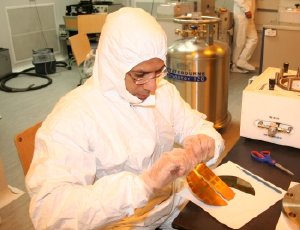Dec 18 2009
Scientists at AUC are currently engaged in ground-breaking research in nanoscience and technology-oriented fields that are expected to change the way we live our lives in the near future. Through the Yousef Jameel Science and Technology Research Center, AUC faculty are conducting cutting-edge research that includes the development of novel diagnostic tests for sensitive detection of the hepatitis C virus; detection of cancer biomarkers, as well as creating a new generation of nano-devices that include smart bricks with tiny sensors, which can analyze building safety and warn of fires and earthquakes.

Nanotechnology is the science of the very small, dealing with atoms and molecules. “One has to visualize how small a nanometer is. It is 1x 10-9 meters or one one-billionth of a meter long. They are incredibly small and professors working on the nano-scale are looking at a world most people simply would not recognize,” Sherif Sedky, physics professor and associate director of the center said, adding that AUC professors are constructing miniaturized devices. These devices are commonly referred to as microelectromechanical (MEMS) and nanoelectromechanical (NEMS) systems, which are used in a broad range of applications, including communication systems, blood pressure regulation devises, muscle stimulators, and high-density storage media. “The field is only 15 years old, but nearly every system you can think of has some MEMS component in it, from pharmaceuticals and mobile phones to the wing of an airplane and the fabric of stain-resistant shirts,” Sedky said.
Recently, Sedky and the microfabrication group that he heads have secured a patent jointly owned with the Interuniversity Microelectronics Center in Belgium for their development of new techniques that control the physical properties of thin films. These will be suitable for a broad range of miniaturized devices that can be integrated with driving and control electronics. “We are also working on developing energy harvesters that could convert wasted energy into a useful one, which could then be used to charge devices implemented inside the human body, as well as developing miniaturized antennas and high precision motion systems that are suitable for space applications,” he explained.
Leading the research efforts in the field of bionanotechnology, Professor Hassan Azzazy, chair of AUC’s chemistry department, constructs and utilizes a variety of nanoparticles including gold nanoparticles and nanocrystals to develop unique diagnostic tests for sensitive detection of the hepatitis C virus. “Nanoparticles are also used in different test configurations to develop experiments for the detection of cancer biomarkers such as alpha-fetoprotein, a marker of hepatocellular carcinoma (liver cancer),” said Azzazy, adding that these nanoparticle-based tests are cheaper and generate results in a shorter time compared to their commercial counterparts. “We are also working on designing nano-carriers for controlled simultaneous delivery of therapeutic drugs and genetic materials into liver cells using built-in nano-switches,” he explained.